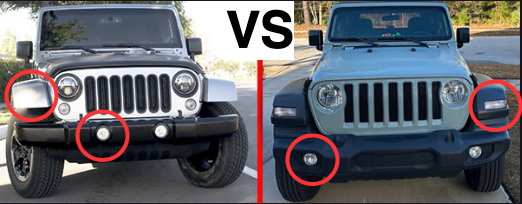This post contains affiliate links. If you click on a link and make a purchase, we may earn a commission at no additional cost to you.
The Jeep Wrangler has long been an iconic symbol of off-road adventure, and its evolution over the years has captured the hearts of enthusiasts worldwide. In this article, we’ll briefly look into the history of two significant iterations of the Wrangler series – the Jeep Wrangler JK and Jeep Wrangler JL – exploring their origins, key differences, and the innovations that have made them stand out in the rugged terrain.

Jeep Wrangler JK
The Jeep Wrangler JK made its debut in 2007, succeeding the TJ model. Manufactured by Jeep, a division of Stellantis (formerly Fiat Chrysler Automobiles), the JK continued the tradition of the Wrangler’s robust off-road capabilities while introducing modern features for improved comfort and convenience.
The JK was produced in various body styles, including two-door and four-door options, offering flexibility for different preferences. It retained the classic Wrangler styling but incorporated updates like a more refined interior, advanced safety features, and enhanced suspension systems.
Jeep Wrangler JK became an instant favorite among off-road enthusiasts, cementing its place as a reliable and versatile choice for those seeking both on-road comfort and off-road prowess. Its production spanned until 2018, leaving behind a legacy of exploration and adventure.
Jeep Wrangler JL
In 2017, Jeep introduced the Wrangler JL as the successor to the JK model. Continuing its manufacturing under Stellantis, the JL aimed to build upon the success of its predecessor while addressing areas for improvement.
The JL brought forth a more modern and aerodynamic design, with subtle changes to its iconic silhouette. Built on an all-new platform, the JL featured lightweight materials, contributing to improved fuel efficiency without compromising its off-road capabilities.
One notable upgrade in the Wrangler JL was the introduction of an available turbocharged four-cylinder engine, providing an additional option for those seeking a balance between power and efficiency. The interior received a significant overhaul, incorporating updated technology and infotainment systems to meet the expectations of the modern driver.
Production of the Wrangler JL showcased a commitment to innovation, adapting to the evolving needs of the automotive market while staying true to the Wrangler’s rugged heritage.
Key Difference between Jeep JK and JL
- Design and Platform:
- The JL boasts a more refined and aerodynamic design compared to the boxier JK.
- The JL is built on a new platform with lightweight materials for improved performance and fuel efficiency.
- Jeep JL includes LED daytime running lights and turn signals embedded into the front fenders.
- Jeep JL Wrangler features a raked windshield. (see Video below)
- Engine Options:
- While the JK offered traditional V6 engines, the JL introduced a turbocharged four-cylinder option for increased efficiency.
- Jeep JK Engine: 3.6L Pentastar V6, 285 hp, 260 lb-ft
- Jeep JL Engine: 3.6L Pentastar V6, 285 hp, 260 lb-ft
- Jeep JL Engine: 2.0L Turbocharged I4, 270 hp, 295 lb-ft
- Jeep JL Engine: 3.0L EchoDiesel V6 (2019+) 260 hp, 442 lb-ft
- Interior Features:
- The JL’s interior received a significant upgrade, incorporating advanced technology and infotainment systems for a more modern driving experience.
The evolution from Jeep Wrangler JK to Jeep Wrangler JL represents a thoughtful progression in the world of off-road vehicles. Both models have left an indelible mark on the automotive landscape, offering enthusiasts a blend of rugged capability and modern comfort. Whether you’re a fan of the classic styling of the JK or the innovative features of the JL, the Wrangler series continues to embody the spirit of adventure on and off the road.
This post contains affiliate links. If you click on a link and make a purchase, we may earn a commission at no additional cost to you.






































